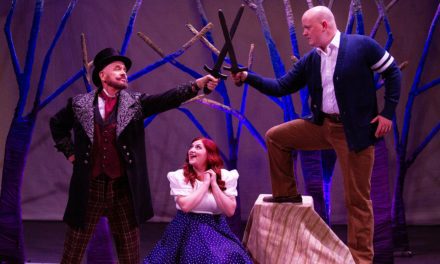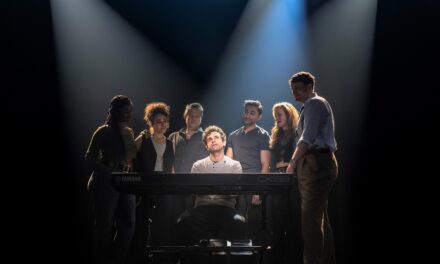SALT LAKE CITY — Watching Ramona Quimby at The Children’s Theatre reminded me what it felt like to be nine years old. For ninety reminiscent minutes, I got to join Beverly Cleary’s grade school heroine Ramona as she learned some of childhood’s hardest lessons. I watched empathetically as Ramona learned that grownups aren’t perfect, life isn’t always fair, and sometimes you have to say you’re sorry even when you don’t mean it. The play is genuine and charming and appeals to both children and adults, for perhaps the same reasons: we’ve all been there (even if for some of us it was a bit less recent than for others).
The play follows the Quimby family and their life on the middle-class American Klickitat street. We join the teenage Beezus (played by Baily Weems) and 8 year old Ramona (Haley Brock) on the first day of school. Third grade ends up not being all it’s cracked up to be. This year in school, Ramona deals the notoriously strict Mrs. Griggs (Lynn Marie Jennings-Johnson), her show-off classmate Susan (Savannah Sondrop), and the fact that she forgot to bring something for show-and-tell. Even spending time with her best friend Howie Kemp (Joshua Stephens) becomes less appealing when his Uncle Hobart (Austin Smith) moves home and begins making passes at Ramona’s cool (and eligible) Aunt Bea (Madeline Richardson).
Even when times get rough, Ramona and Beezus always find solace at home. The Quimby family is the suburban American ideal. Even though the family faces adversity, and everybody doesn’t always get along, they all clearly love each other. Ramona’s father Bob Quimby (Taylor Smith) is endearing and goofy, and his wife Dorothy Quimby (Jillian Brenner) is both gentle and stalwart.
Ramona reminded me how hard it is to be a child in an adult’s world. At eight years old, she is starting to understand the world around her, but is still powerless to do anything about most of it. Ramona reminded me how it feels to learn, for the first time, that your father might try his best and still fail; that grownups don’t always keep their promises; that it’s possible to love someone even when they drive you crazy half the time; and that a dinner at Whopperburger can’t always make everything all right.
I loved that even Beezus (called such because Ramona, as a small child, was unable to pronounce Beatrice), who tries so hard to act grown-up, even admits that sometimes she still finds the world big and frightening. The sentiment of the entire play could probably best be summed up in the interchange when Beezus exclaims, “Ramona needs to grow up!” and Ramona responds, “Can’t you see I’m trying?”
All of the acting was adorable. With a cast entirely of children, I didn’t expect Broadway, and I didn’t get it. But I got a fantastic performance. The actors were able to portray the genuine excitement and unmitigated emotion that children constantly feel and express in a way that is perfect for this, a play that is really about childhood.
I’ll only mention a few of the actors whose performance was far ahead of their years. Haley Brock, as Ramona Quimby, was simply enchanting. She leapt across the stage with boundless energy, had beaming facial expressions, and played an entertaining and convincing part. Bailey Weems, as Beezus Quimby, was perfect as the young teen who is aching to enter adulthood but can’t quite leave childhood behind. She did a great job portraying her sibling rivalry with Ramona while still showing how much she loved her. I may have been most impressed by Taylor Smith, as Bob Quimby. This young actor was both convincing and a joy to watch in the part of the loving father who uses laughter to get his family through hard times. (At one point he exclaims, “We are going to be nice and get along with each other if it kills us! That’s an order!”) And, in a minor part, I still laugh every time I think of comedic relief provided by Kate Abbott as the Whopperburger Waitress Tammy.
I really appreciated the simplicity of the set and stage because the absence of any distractions allowed the audience to really focus on the actors themselves. While there were some great props and scenery pulled in from time to time, for the most part the setting was fairly simple and allowed the audience to use their imaginations. When Ramona was in school, I pictured her sitting in my own third grade class room. The absence of an elaborate set made the play more personable because it allowed the audience to imagine a setting familiar to their own childhood. I’ll admit the effect was done well enough to bring me to reminiscent tears at one point.
I loved Ramona Quimby and would see it again in a heartbeat. The story, the set, and the actors were darling, and the play appeals to both children and adults. No matter how old you are, this play will remind you what it’s like to be a child.





